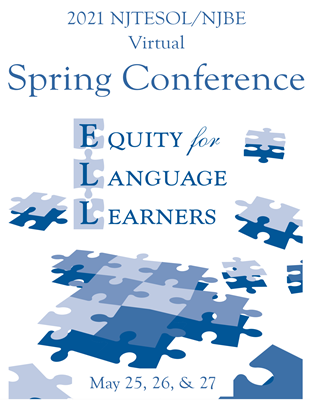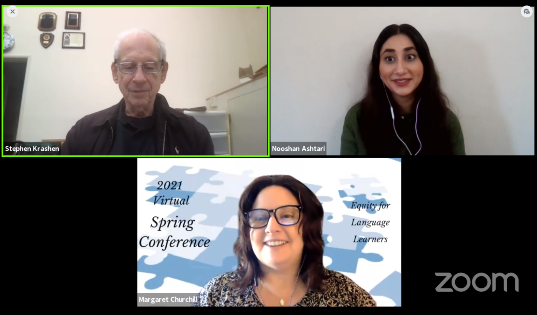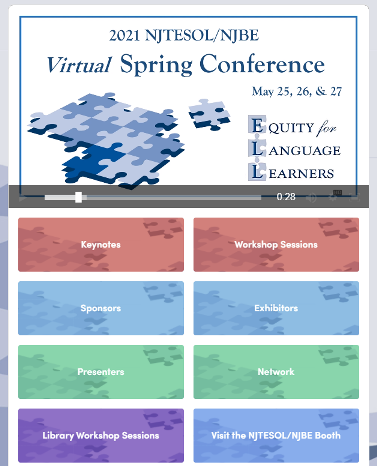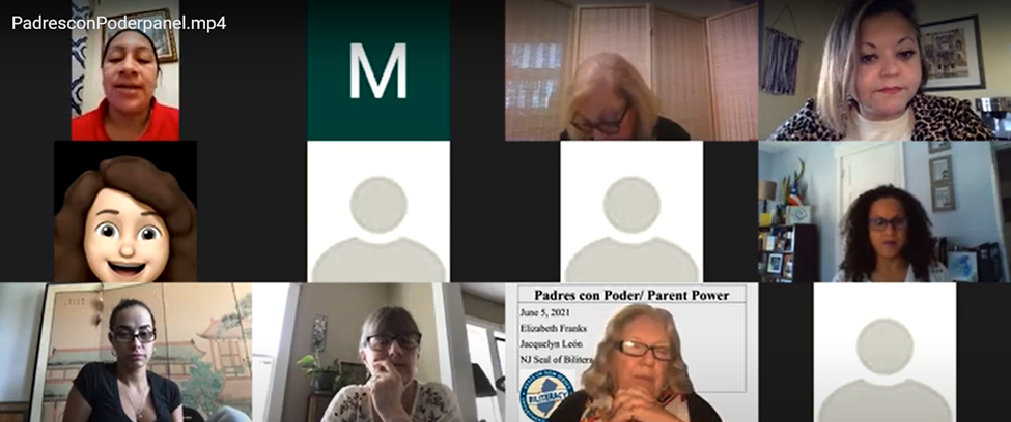NJ Teachers of English to Speakers of Other Languages/
NJ Bilingual Educators
ARTICLES – SPRING 2021
Our New Normal: How ELL Educators are Advocating for Our Students and Our Profession During COVID-19– LeighAnn Matthews
Thirteen Instructional Strategies for Supporting ELL Newcomers
Vocabulary Tips and Hints for English Learners
Metacognitive Activities for Vocabulary Growth
Through the Eyes of a Bilingual Student– Tina Kern
Proof for What We Know Supports for Students
Six Myths about Emergent Bilinguals
How to keep our most vulnerable students from losing ground in the pandemic– Tawana Grover
Educators have a basic but essential role in dismantling racism
6 Ways to Build Fluency in Second Language Writing– Betsy Gilliland
5 Effective Modeling Strategies for English Learners
An Intensive English Program in the Pandemic– Claire Fisher
4 Positive Psychology Tactic to Help Your Brain Manage Stress
Use Text Sets to Benefit Bilingual Students
The Science of Reading in Dual Language
Transmediation for Digital Literacy Learning
Notice for Spring Conference Attendees
March 23, 2021
Our New Normal: How ELL Educators are Advocating for Our Students and Our Profession During COVID-19
 LeighAnn Matthews addresses the past, present and future in her article on the Colorin Colorado website, providing insights and ideas to carry us forward in the uncertain return to the classroom.
LeighAnn Matthews addresses the past, present and future in her article on the Colorin Colorado website, providing insights and ideas to carry us forward in the uncertain return to the classroom.
First she lists the strengths of ELL educators, among which are making do with little, communicating with parents and other educators, believing in their student’s potential, advocating for them, and more. This is followed by a list of sometimes overwhelming challenges such as teaching virtual, hybrid, and or in-person classes, and for some, in different schools. Included in this are determining placement, finding online resources, supporting students remotely, and figuring out how to teach online.
Then LeighAnn presents small, manageable steps towards solutions, the first of which is to decide what you can do based on what you can control and what will have a positive outcome for your students. She concludes by saying,
“This pandemic is pushing us harder than any experience we, as educators, have had before. By identifying your own challenges, changing the ELL narrative around you, and enlisting more allies, however, you can become a stronger ELL advocate while finding ways to get through this pandemic..”
Read about 7 more steps you can take.
LeighAnn Matthews is the NJTESOL/NJBE Executive Board Liaison for Chapters and other TESOL Affiliates
Article recommended by Barbara Tedesco, NJTESOL/NJBE Executive Board Archivist/Historian
Thirteen Instructional Strategies for Supporting ELL Newcomers
 In the opinion blog on EdWeek, Larry Ferlazzo. answers the question about strategies to use with newcomers to the United States. First, he briefly lists five of his own and then those of other educators, some of whom he hosted on his 10 minute radio show, BAM!
In the opinion blog on EdWeek, Larry Ferlazzo. answers the question about strategies to use with newcomers to the United States. First, he briefly lists five of his own and then those of other educators, some of whom he hosted on his 10 minute radio show, BAM!
His first strategy is to have students label images in a picture with words, build these into sentences and after that, create a paragraph. Second are games, which make learning fun, and he mentions a few, both online with links, and in-person, particularly one in which students partner to write sentences for display in the room. Another activity on his list is funny, dramatic dialogs that students can perform or record. His two other activities involve a discussion based on an image of a problem, and writing about an activity or video.
Next on the list are Michelle Shory and Irina McGrath, educators and co-creators of the website, ELL 2.0. They advise teachers to learn about their students’ cultures, history, language, and education systems in order to create a curriculum that is culturally relevant. They also encourage teachers to build relationships with their students, foster independence by ensuring that students can navigate the online world, and give ample opportunity for conversational interaction. They conclude by stating that,
The more effort teachers put into getting to know their students, teaching them self-advocacy skills, and building on their funds of knowledge, the greater chance their students will have of reaching their highest potential and succeeding personally and professionally.
Among her recommendations, Luisa Palacio, an ESL and Spanish teacher from Colombia, suggests setting up mentors to guide newcomers in navigating their new school and culture.
Sean McWherter, Ed.D., the director of restart programs for the Guilford County schools in North Carolina, advocates for incorporating language learning goals, for reading, writing, speaking and listening in all lessons.
See the full article with links to activities.
Article recommended by Hana Prashker, NJTESOL/NJBE ESL Secondary Rep.
March 30, 2021
Vocabulary Tips and Hints for English Learners
 The author, Douglas Magrath, recommends that students read a lot in order to learn English naturally rather than trying to memorize lists of vocabulary words. Instead, he outlines several activities to reinforce word concepts.
The author, Douglas Magrath, recommends that students read a lot in order to learn English naturally rather than trying to memorize lists of vocabulary words. Instead, he outlines several activities to reinforce word concepts.
- The first of his suggestions involves context and culture, that is, to draw from the students’ cultures, for example, what is one word in English, might be two or more in another language
- Second, to find stories with academic vocabulary, which the instructor might read aloud as a listening activity.
- He also recommends a game he calls Vocabulary Sweep-up. Cards with individual words on them are spread out on a table, and students pick them up one by one and use the word in a sentence that demonstrates their understanding of the word.
- The fourth idea is the use of concept maps that students create with text, images, videos, different meanings, word use, and related words.
The author concludes with a short list of other suggestions for vocabulary building which include acting, related ideas, and translating.
See all of Magrath’s suggestions.
Deadlines are approaching, but there’s still time!
NJTESOL/NJBE Executive Board Nominations – Final date: April 1
Participate and grow professionally
Scholarships – Due: April 16
Amazing scholarships and awards – 1 for teachers, too!
Spring Conference – Regular registration ends May 1
Metacognitive Activities for Vocabulary Growth
 The three activities detailed by Rita F. Naughton help students analyze their own strategies for learning vocabulary by requiring evaluation of personal knowledge of the words to be studied. The activities are extensive and analytical, suitable for intermediate to advanced level students in college, high school, and possibly middle school.
The three activities detailed by Rita F. Naughton help students analyze their own strategies for learning vocabulary by requiring evaluation of personal knowledge of the words to be studied. The activities are extensive and analytical, suitable for intermediate to advanced level students in college, high school, and possibly middle school.
For the Word of the Day, students prepare posters to present to their classmates. The posters contain definitions, synonyms, antonyms, collocations, and illustrations. The students are required to ensure that their classmates can understand the content on the poster.
In Rate It – Rating and Raising Word Knowledge, students choose one of four levels of their comprehension of vocabulary words. They must explain their rating, share what the words mean, and through follow-up questions, tell how they arrived at their conclusions.
A Vocabulary Quilt begins with determining parts of speech, and then asks students to analyze their strategies for where they placed the words and reflection on the process.
The steps for each activity may seem long, but each of these provide ample vocabulary practice. By the time they are completed, the words will be remembered, and students will have increased their awareness of their own strategies for leaning.
Get the steps for the activities.
Articles recommended by Hana Prashker,
NJTESOL/NJBE ESL Secondary Representative
April 6, 2021
Through the Eyes of a Bilingual Student
By Tina Kern
 He enters the classroom, pairs of eyes staring at him, watching his discomfort. He feigns courage that stems from years of having to adapt to conditions that constantly have been morphing and changing him since that initial harrowing and dangerous trip from Central America over the border to the United States. Again, his inner strength is being challenged. Was it only three years ago that he met his “new” family consisting of a mother who left him 12 years ago to the custody of an aging grandmother who attempted to fill the gap left behind? Then he struggled to fit into a society and culture so different from his own and tried to integrate into a school that looked, sounded, and felt so foreign and unfriendly. His personal journey was not complete, and maybe would never be. Meanwhile the next step was taken as he walked across the threshold of, his first mainstream content classroom, alone in yet another challenging situation. This was so different from his bilingual classes where his teachers enveloped him in a secure, friendly, environment with other students that resonated with and reflected his transformation.
He enters the classroom, pairs of eyes staring at him, watching his discomfort. He feigns courage that stems from years of having to adapt to conditions that constantly have been morphing and changing him since that initial harrowing and dangerous trip from Central America over the border to the United States. Again, his inner strength is being challenged. Was it only three years ago that he met his “new” family consisting of a mother who left him 12 years ago to the custody of an aging grandmother who attempted to fill the gap left behind? Then he struggled to fit into a society and culture so different from his own and tried to integrate into a school that looked, sounded, and felt so foreign and unfriendly. His personal journey was not complete, and maybe would never be. Meanwhile the next step was taken as he walked across the threshold of, his first mainstream content classroom, alone in yet another challenging situation. This was so different from his bilingual classes where his teachers enveloped him in a secure, friendly, environment with other students that resonated with and reflected his transformation.
After the usual introductions and “icebreakers”, the class began in earnest. Everyone seemed to know what to do, almost like a well–rehearsed dance. But he was out of step and lost. The teacher explained what to do, but then seemed to fade into the background as students took out their computers and began to confidently start their assignments. He was lost, yet not able to admit his confusion, as he couldn’t even voice what his questions were.
The teacher walked around the room, checking here and there, but as she approached his desk, he looked steadily at the screen and began to type as the teacher nodded and moved on. He faked it because his questions said out loud would only cause the class to look at him like he was not meant to be in the class with them.
That night the teacher looked at the work her students had accomplished that day. Though his work had some correct answers, it was lacking in the structure and comprehension that the assignment needed for successful completion, so she translated it. The next day of class, the teacher smiled widely as she passed his desk. She was thrilled to see that he was redoubling his effort now that he was presented the same work in Spanish.
But again the teacher was disappointed to find that his work had not improved. Obviously, she had to watch him carefully for signs that he needed to be tested for disabilities. It was apparent that if he couldn’t successfully complete the work in English or Spanish, there was a problem. She would document all of his behaviors and assignments. and refer him to what she thought was an appropriate path.
 What the mainstream classroom teacher did not realize was that he was from Guatemala, and Spanish was his second language. His first language was Mam. He spoke his native language fluently, but he had not mastered reading and writing it because in his village there was no need to acquire these skills. He had entered school without any knowledge of Spanish at all. He painfully learned his second language, Spanish, and spent the first few years studying how to read and write it. Then upon entering the United States’ school system, he was introduced to his third language, English. He was not strong in his language skills, and found the vocabulary, syntax and phonics quite a challenge.
What the mainstream classroom teacher did not realize was that he was from Guatemala, and Spanish was his second language. His first language was Mam. He spoke his native language fluently, but he had not mastered reading and writing it because in his village there was no need to acquire these skills. He had entered school without any knowledge of Spanish at all. He painfully learned his second language, Spanish, and spent the first few years studying how to read and write it. Then upon entering the United States’ school system, he was introduced to his third language, English. He was not strong in his language skills, and found the vocabulary, syntax and phonics quite a challenge.
Many of our Bilingual students find that learning a new language in a new culture while trying to negotiate the labyrinth of our educational system is a colossal task. It is a race against time as many of our high school students come here late in their teens. Our students struggle while mainstream teachers who speak Spanish, hired because of the lack of certified bilingual educators, try to help by sometimes watering down or translating content. They have not yet been introduced to the strategies for our ELLs. These teachers are asked to take courses each semester to become certified in bilingual education, but this is a slow process.
Collaboration with these teachers can help them and our students. In my high school, we have begun to assess reading in English and Spanish with standardized assessment tests three times a year to ascertain beginning grade levels or lexiles in reading, and then assess growth. It is an “aha” moment when teachers see that their students are reading at a 5th or even 1st grade level. Once made aware of this, we can help the teachers provide a means for the student to reach course objectives by providing the necessary scaffolding.
Some of the strategies to help teachers differentiate are graphic organizers, visuals, word boxes, and framed sentences and paragraphs. By framing sentences instead of using sentence starters, the teacher is providing the means for the student to “show what they know” and demonstrate their mastery. Additionally, having students share in the objectives of each day gives them a sense that they are moving forward in what they are learning.
Sometimes, as teachers, we have to put ourselves in the place of our students or see through their eyes as we plan. We can plan from the goal backwards to the beginning (backward design), considering the students’ background knowledge, reading level, and any and all data. Sometimes the smallest step to help our students can provide at least one less stress in their lives, and perhaps, provide a pathway to success. We can help open the door. We can be the gateway, not the gatekeeper, of their future.
Tina Kern is a bilingual teacher in the Morristown Public Schools and the NJTESOL/NJBE Exhibitor Liaison.
April 13, 2021
Proof for What We Know – Supports for Students
 These two articles from EdResearch for Recovery supply information and statistics that can be used to advocate for our students and their families. They also include common issues and a number of helpful strategies with sample activities.
These two articles from EdResearch for Recovery supply information and statistics that can be used to advocate for our students and their families. They also include common issues and a number of helpful strategies with sample activities.
Supports for Students in Immigrant Families describes the efforts of a California school district which asks parents to plan meeting agendas and help determine the allocation of resources. It also mentions partnering with local organizations outside of the school for additional resources.
In the list for at-home learning activities, the article states that Homework should provide English learners with an opportunity to develop language skills and reinforce content without demanding an unrealistic level of academic English proficiency. It also mentions posting messages of inclusion and encouraging students to tell their own stories.
Supports for Students Who are English Learners (ELs) recommends promoting bilingualism by encouraging biliteracy. Ideally, there should be collaboration between content-area teachers and ESL instructors. The article espouses using high-quality lessons and resources including those that are digital and designed for ELs to encourage, reading, writing, speaking and listening. Extra practice in small groups or one-to-one with a teacher. after-school programs and reading buddies are also recommended.
The article emphasizes not allowing funds to be diverted to other district needs, ensuring privacy, especially for undocumented immigrant families, providing a means to avoid discrimination and assisting students who have suffered trauma.
Reminders
- This is the final week for Scholarship Applications
- There are only three weeks left for Spring Conference registration
- Vote for the new members of the NJTESOL/NJBE Executive Board – Check your email for the link.
- Burlington ESL Consortium – Next Meeting: April 27 from 1:00 – 3:00 with Lori Ramella from NJDOE Only 75 seats – Click here to register.
Six Myths about Emergent Bilinguals
 Carol M. Johnson and Doris Chávez-Linville reveal how the truth about these six myths is helpful not just for teachers of English learners but for all educators.
Carol M. Johnson and Doris Chávez-Linville reveal how the truth about these six myths is helpful not just for teachers of English learners but for all educators.
In a conversational article, the authors focus on common myths about English learners.
- Young students learn language better than older students, who might be in a college setting. Older students often have difficulties with pronunciation, but they are good learners.
- The consideration that a lack of English is a deficit rather than having a native language as an asset.
- English is more complex than other languages. The author’s belief is that all languages are complex in different ways.
- ELs will always feel that they are not fully part of any group. However, the writers state that understanding the students’ cultures and welcoming them into their new one, will help them feel like they can fit in.
- English only will promote language acquisition the fastest, rather than dual language programs.
- The final incorrect idea is that language should be taught separately from other subjects.
Read the full conversation here.
Articles recommended by Hana Prashker, NJTESOL/NJBE ESL Secondary Representative
April 20, 2021
How to keep our most vulnerable students from losing ground in the pandemic
Nebraska superintendent says dismantling structural and racial inequities will help
 The author, Tawana Grover, the Superintendent of the Grand Island, Nebraska School District, writes from the perspective of herself being a target of racism. She comments how the pandemic has shone a light on the deep and long-standing problem of racial inequities.
The author, Tawana Grover, the Superintendent of the Grand Island, Nebraska School District, writes from the perspective of herself being a target of racism. She comments how the pandemic has shone a light on the deep and long-standing problem of racial inequities.
With innovative approaches to learning coming out of the pandemic, school and district leaders now have the power to dismantle long-standing bureaucratic and inequitable systems and demand new rules to maximize the experiences of each and every student.
She lists five “D’s” as a guide for “dismantling inequities.”
- Define equity for your school district. Involve all stakeholders and include what will be done to carry it out.
- Distribute data to all personnel – Collect enough data to evaluate every student’s growth and use it to guide decisions and instruction.
- Discuss implications and complexities – Learn about students’, their families’, and school staff’s experiences in life. In discipline, focus on support and growth with the goal of eliminating biases
- Disseminate resources equitably, not equally – This includes not only physical resources, but also personnel so that students with the greatest need have the highest level of instruction with a rigorous curriculum
- Develop policies carefully to be sure they do not become barriers, and seek community partners to eliminate financial hurdles.
Education is today’s civil rights movement, and we must act boldly and with urgency to stamp out injustice.
Educators have a basic but essential role in dismantling racism
 In a related article, Arlene Ford tells the story of her cousin, a bright college graduate being unable to land a job that corresponds to his abilities due to a lack of counseling in job-hunting and resume-building skills. This being a result of not being afforded the resources he needed to succeed because of racism.
In a related article, Arlene Ford tells the story of her cousin, a bright college graduate being unable to land a job that corresponds to his abilities due to a lack of counseling in job-hunting and resume-building skills. This being a result of not being afforded the resources he needed to succeed because of racism.
Years before, as a volunteer, she discovered glaring inequities in a middle school due to racism. She found that a good number of the students could barely read.
She states that one of the factors that perpetuates inequity is blaming the students, their families, or a lack of resources. Rather than maintaining this attitude, she urges educators to support the students in their classrooms, especially preparing them for the workforce with life-skills training, mentor programs, and healing from the effects of the racism they encounter.
Each of us has something to say about what happens next, but educators have the critical job of preparing their students for that new world, including showing them the concrete steps they must take to get there.
April 27, 2021
6 Ways to Build Fluency in Second Language Writing
 The author, Betsy Gilliland, first discusses various descriptions of fluency. She mentions that according to some researchers, fluency is defined as writing for a length of time without stopping to make corrections, and that fluency, accuracy, and complexity are corresponding measures of writing. Surprisingly, some research has shown that efforts to correct while writing result in less fluency.
The author, Betsy Gilliland, first discusses various descriptions of fluency. She mentions that according to some researchers, fluency is defined as writing for a length of time without stopping to make corrections, and that fluency, accuracy, and complexity are corresponding measures of writing. Surprisingly, some research has shown that efforts to correct while writing result in less fluency.
Gilliland states that the goal in writing is for students to be able to put their ideas on a paper or screen successfully. Although her focus is college students, it can apply to other age groups as well.
Her six suggested activities are:
- Word association – Use games to build vocabulary.
- Looping – Have students write for 5 minutes, and then choose a word they wrote and write about that word. Repeat this a few more times. Another option is to rotate the texts from one student to another.
- Academic Chunks – Practice with common phrases used in writing.
- Planning before writing – Have students brainstorm, draw graphic organizers, use looping, and make outlines.
- Writing Blind – Darken the students’ screens and so they write without being able to look back at what was written before.
- Rewards or Consequences – Use one of two websites, one with a visual reward after every 100 words, the other with a punishment for stopping too long: the text starts to automatically delete if writing is paused too long.
Finally, once their ideas are written, students can work on revising and editing, but something must be written first!
5 Effective Modeling Strategies for English Learners
Daria Witt and Michael Soet encourage the use of modeling as a basic method of scaffolding for writing and math. The article provides models for teachers, too.
The authors argue that while some may say that modeling makes tasks too easy, it helps students focus on the core of the assignment without wasting time guessing at what they should do.
 These are the five strategies that they suggest.
These are the five strategies that they suggest.
- Do the first of similar questions
- Use visuals to show what is expected, such as a Venn diagram
- Provide sentence frames to guide conversations about the topic
- Create a video to show each step of the process for the assignment
- Break up the task into chunks or steps
Using models gives greater opportunity for success not only for English learners but for other students as well.
Articles suggested by Hana Prashker, ESL Secondary Representative
May 4, 2021
An Intensive English Program in the Pandemic
 Claire Fisher, an adjunct professor at Pratt Institute’s Intensive English Program (IEP), looks back on the past year of teaching online. Although her specific circumstances and challenges are different from K-12 ESL and bilingual educators, the emotion, inspiration, determination, and adaptations are what we’ve all experienced.
Claire Fisher, an adjunct professor at Pratt Institute’s Intensive English Program (IEP), looks back on the past year of teaching online. Although her specific circumstances and challenges are different from K-12 ESL and bilingual educators, the emotion, inspiration, determination, and adaptations are what we’ve all experienced.
There were the sudden changes of students and classes transitioning from in-person to online, and then for the students having to leave their dorm rooms, many of whom returned to their home country, China. Her teaching schedule had to change to accommodate the time differences. They were all stressed.
She had to learn online apps, completely change her teaching methods, and adapt her course requirements to ease her students’ stress. Her job description broadened to not only educator, but also health counselor, technology trainer, and therapist.
Yes, in spite of all of this, she is positive and hopeful, valuing what she has learned. She concludes by writing that,
Being online constantly is still difficult, and it will be for the duration of this pandemic. Nevertheless, one year in, I’m proud of myself and my IEP colleagues for how creative and resilient we’ve been.
4 Positive Psychology Tactics to Help Your Brain Manage Stress
If you’re feeling overwhelmed today, you’re not alone. Teachers across America are struggling with unprecedented levels of mental stress. At the start of the COVID-19 pandemic, the Yale Center for Emotional Intelligence conducted a national survey of more than 5,000 U.S. teachers.
When asked to describe their mental health and stress levels, the five most common terms that educators used were “sad,” “overwhelmed,” “anxious,” “fearful,” and “worried.” Thankfully, positive psychology can help you to build your resilience to stress, prevent burnout, improve your overall well-being, and lead to better outcomes in your classroom.
Carrie Drake, from Reading Horizons, describes the sources of stress and how it affects your health and your ability to teach. Her solution is to change your outlook on the stress you are experiencing.
She recommends four strategies.
- Don’t believe that the worst outcome will occur.
- Engage in positive self-talk.
- Look for the good that might result from the situation.
- Focus on the facts and what you can do.
Finally, she also suggests reaching out for and accepting support from others.
May 11, 2021
Use Text Sets to Benefit Bilingual Students
 Elizabeth Hagan, Dr. Lisa Friesen, Casi Hodge, and Sunday Cummins identify an issue for English learners when their reading practice spans a wide variety of unfamiliar topics. This does not give students the opportunity to master any of the concepts.
Elizabeth Hagan, Dr. Lisa Friesen, Casi Hodge, and Sunday Cummins identify an issue for English learners when their reading practice spans a wide variety of unfamiliar topics. This does not give students the opportunity to master any of the concepts.
As part of a professional inquiry, we began to ask ourselves how we can ease the cognitive load for emergent bilinguals so they can develop a depth of knowledge on a topic or issue while also learning how to become strategic readers.
To do this, they propose using multiple readings from various sources on a single topic. Based on information about the students, the teacher should choose a topic that would be high interest for the students.
Basic questions about the topic can be used to ensure that the readings complement each other. Students become more confident and learn to be strategic readers as they raise additional questions that they can research for independent study.
See the authors’ analogies and sample topic.
Announcements
We are looking forward to our Virtual Spring Conference
for all who are able to attend!
Parent Expo – Padres con Poder/Parent Power
Parents of Multilingual Learners join us for Padres con Poder/Parent Power, NJTESOL/NJBE’s FREE virtual workshop on Saturday, June 5, 8:30 – noon!
There will be live presentations, recordings, and an online library of resources available. Topics will include Parents’ Rights at school, health services, immigration, education, college information and more!
Please share with your students’ parents and guardians. Parents can register for this at Eventbrite
The Science of Reading in Dual Language
 Alexandra Guilamo reveals the secrets of biliterate decoding.
Alexandra Guilamo reveals the secrets of biliterate decoding.
The author, a dual language expert, counters the acceptance of the traditional science that states how children learn to read. She writes,
But what the science of reading hasn’t revealed is that the studies only represented “typical classroom teachers” and “typical American or English-speaking students” (National Reading Panel U.S. and National Institute of Child Health and Human Development, 2000).
She states that research proves that students who speak two languages learn to read in different ways, and educators who teach them have to use different methods based on how each language works. This is necessary for dual language students to become proficient readers in both languages.
She compares the use of phonics for teaching reading in English and Spanish. Since Spanish has fewer phonemes than English, less time and effort is required to learn them. Bilingual children then transfer this knowledge from Spanish to English and only need some additional phonetic practice for English.
She suggests that educators pursue, “Collective inquiry into and understanding of the science behind program models, and implementation of language-specific reading processes that may be different but no less valid.”
See Alexandra Guilamo’s five recommendations.
May 18, 2021
Transmediation for Digital Literacy Learning
 Israa Osman describes transmediation as students’ expression of understanding what they read, not through answering questions or writing a summary, but through other mediums such as drawing or making digital stories and videos. For students, this is engaging and creative, and gives them more control of their learning.
Israa Osman describes transmediation as students’ expression of understanding what they read, not through answering questions or writing a summary, but through other mediums such as drawing or making digital stories and videos. For students, this is engaging and creative, and gives them more control of their learning.
“…because there is no prescriptive way for the students to do this, this act itself encourages inquiry, critical thinking, and the generation of new knowledge.”
For assessment, teachers can compare the lesson content with what students did or did not include in their projects. Osman also presents additional ideas that can be used across the curriculum for this purpose. Some of these are making comics, guessing a story from an image, podcasting, making a book, or writing a song. She finishes her recommendations with a brief list of apps.
In addition to the benefits listed above, transmediation supports digital literacy.
Click here for the ideas and recommended websites.
Notice for Spring Conference Attendees
 An email was sent out Sunday night at 8:30 to each and every registered attendee from noreply@swapcard.com. The subject line was: Welcome to the 2021 NJTESOL/NJBE Virtual Spring Conference.
An email was sent out Sunday night at 8:30 to each and every registered attendee from noreply@swapcard.com. The subject line was: Welcome to the 2021 NJTESOL/NJBE Virtual Spring Conference.
It was sent to the email address that was filled in on your registration form. You must open this email in order to create your password to have access to the 2021 Virtual Spring Conference site. You must use your own email since it is tied to your email address.
Please double check for this email. Don’t see it? Check again! Look in your spam folder. Still don’t see it? Check your personal email address, check your school email, check your other email addresses.
Make sure that your emails from noreply@swapcard.com are not being blocked!!! (You should have already done this.)
Please, please, please double check before contacting gfranks@njtesol-njbe.org.
Take advantage of logging into the conference platform and creating your password right away so that you can learn to navigate the conference site ahead of time and have the best experience. You will be able to set up your schedule and have contact with the sponsors and exhibitors.
Please do not wait until the day before or day of the conference.
When the conference starts, you can watch sessions by our keynote speakers, Dr. Jose Medina, Jane Hill, Dr. Kate Seltzer, and a special guest speaker, Stephen Krashen with Nooshan Ashtari. There are also workshops with WIDA and NJDOE. Join us for the Executive Board Meeting at 4 pm on Wednesday and the Awards Ceremony Wednesday evening at 6 pm. You will also be able to watch the library sessions on demand. You can earn PD for every session up to 10 days afterwards. Interact with the exhibitors and sponsors for points to win one of 11 prizes.
June 8, 2021
Spring Conference Success!
We are thrilled that many of you were able to attend this year’s virtual conference.
Here are some comments from Twitter:
Best conference ever
@NJTESOL_NJBE – YOU CERTAINLY ROCKED IT ! What a privilege to be part of such a distinguished panel of educators. The knowledge, the passion for our EL’s is just palpable.

Q & A with Stephen Krashen & Dr. Nooshan Ashtari, Moderated by Margaret Churchill
Virtual conferences are hard to pull off.
@NJTESOL_NJBE just crushed it! The learning, collegiality, & passion for students was palpable. We @ImagineLearning are so proud to be a part of this wonderful event! See you next year, in person!!!
Wow! From the beginning bang of Medina to Krashen’s lament of the “tortured language of professional literature.”–what a great finale for the best conference ever! So proud to be in this field! Thank-you!
@NJTESOL_NJBE #njtesol_njbe
“Opening with Medina, closing with Krashen, and EVERYTHING in between! This has been an amazing experience!” Truly it has. #njtesol_njbe #njtesolbe
Day 3 of #njtesol_njbe Spring Conference! Amazing presenters! Ended with @skrashen & Dr. Nooshan Ashtari! Thank you
“Let’s get good books and put them in the library” – @skrashen
. WOW! What a simple and inexpensive solution. #njtesol_njbe #njtesolbe
Thank you for attending our virtual 2021 Spring Conference! See you in 2022!
Please be sure to visit our sponsors and see what they have for you.
A Team Effort
Preparing for the 2021 Virtual Spring Conference truly took a team!
It took a lot of hours – for a few of us – all of our non-working and non-sleeping hours the month before and a lot of time prior to that preparing for it.
Thanks to the NJTESOL/NJBE Spring Conference Team
 Michelle Land, Vice-President – helping to choose the platform, lending a hand virtually, brainstorming ideas, and moderating two of the keynotes and breakout sessions
Michelle Land, Vice-President – helping to choose the platform, lending a hand virtually, brainstorming ideas, and moderating two of the keynotes and breakout sessions
Sandee McBride, Conference Coordinator – making sure everything happened in the best way, standing firm for the best experience possible, and connecting with sponsors, exhibitors, presenters and attendees
Gwen Franks, Business Administrator – working behind the scenes in close conjunction with the event builder, to set up and be sure everything was as close to perfect as possible
Marilyn Pongracz, Technology Coordinator – putting together the graphics, setting up ads and gamification for our exhibitors and sponsors, and compiling the data for PD and gamification prizes with the help of Hana Prashker, ESL Secondary Representative and Laura Arredondo, Supervisors Representative
Tina Kern, Exhibitor Liaison – keeping us on track for the sponsors
Maggie Churchill, President – giving ideas and helping with decisions, handling live sessions with invited guests
Executive Board members – moderating sessions
David Wight from ShowGear and his team – finding an amazing platform – setting it up and making sure everything ran smoothly from the beginning through the post conference viewing
We are looking forward to next year at the Hyatt Hotel, New Brunswick for an in person conference, June 1, 2, & 3, 2022 with the infamous chocolate cake and more!
June 15, 2021
NJTESOL/NJBE Parent Expo: Padres con Poder/Parent Power
By Kathleen Fernandez
NJTESOL/NJBE is grateful to all the presenters who made the first NJTESOL/NJBE Parent Expo Padres con Poder/Parent Power virtual workshop so successful. Each presentation will benefit Multilingual Learner parents, guardians, and families. Because so much school and community information is in English, parent involvement is difficult for adults who speak another native language.
With the Padres con Poder/Parent Power Workshops, this essential information was made accessible because sessions were presented in Spanish or bilingually, but also because there is closed caption translation accessibility on the YouTube videos. This enables these families the opportunity to navigate the education system and other essential life skills with success.
 These presentations were recorded and are now available for everyone to use with their ELL/Bilingual/Dual language communities.
These presentations were recorded and are now available for everyone to use with their ELL/Bilingual/Dual language communities.
- Nedia Morsey from Make the Road NJ did a presentation on Driver’s Licenses and shared a video answering questions about their summer academy to help high school students prepare for college.
- Spirit of the Wind discussed immigrants’ rights in the presentation “We are Home”.
- Jason Pedraza, from the Education Law Center, related information about NJ funded Preschool programs.
- Elizabeth (BJ) Franks spoke about the Seal of Biliteracy and the importance of maintaining students’ native language skills.
- Ms. Maritza Villanueva, from New Village Consultants; Mr. Ulises Prudencio, and Dr. Dr. Nancy Chae, Assistant Professor (with Alina Sanchez and Emily Young) from Montclair State University, provided guidance on family concerns like educational technology, overcoming setbacks, and preparing for college.
- A particular highlight was the Parent Panel, consisting of Yolanda Hernandez, NJTESOL/NJBE Parent Representative, Isabel Basurto, and Nancy Burgos, who spoke about their experiences dealing with school issues related to their children.
You can find these presentations and more on the NJTESOL/NJBE Parent Expo YouTube page.
The Parent Expo Resource Page 2021 is the culmination of all the video presentations and additional information in our Expo Hall. There are links and short videos from several New Jersey Community Colleges, SPAN, NJPTA, New Labor, and the NJ Department of Children and Families. Much of this information is available in Spanish and English. This is a wonderful resource to share with your parents and to use for Parent committee meetings next school year.
Kathleen Fernandez is the NJTESOL/NJBE Executive Director
Parent Support for High School Students
by Hana Prashker, Patricia George, and Elizabeth Franks
Many former and current English Language Learners (ELLs) may:
- be the first person in their family to attend college.
- attend college part-time so that they can earn money to support their family.
- take a “non-traditional path” and take longer to finish their degree.
Ways that parents can support their children during high school
- Parents should ask for a translator for all school-related meetings and for all school-related documents.
- Parents should make an appointment with their child’s school counselor in their freshman year in order to become familiar with school services, including:
- the college application process, important deadlines, and opportunities
- Financial Aid
- the importance of attendance, extracurricular activities and participating in community service
- Parents need to encourage their children to seek assistance from staff members to help their child compose essays and obtain letters of recommendation from employers, advisors, teachers, and community members.
Recommendations for ELLs, Former ELLs and Generation 1.5 students
- Students themselves need to learn various ways to advocate for themselves and ask for help..
- Students must attend school regularly. If students are having difficulty getting to school, they should ask to meet with the attendance officer or counselor to work out a plan.
- Students need to ask for extra help from ESL, bilingual and content area teachers.
- Students should participate in extracurricular activities (sports, clubs, volunteering) to build relationships and create opportunities to use English outside of the classroom.
 Visit our home page for links to past and present Voices issues.
Visit our home page for links to past and present Voices issues.
